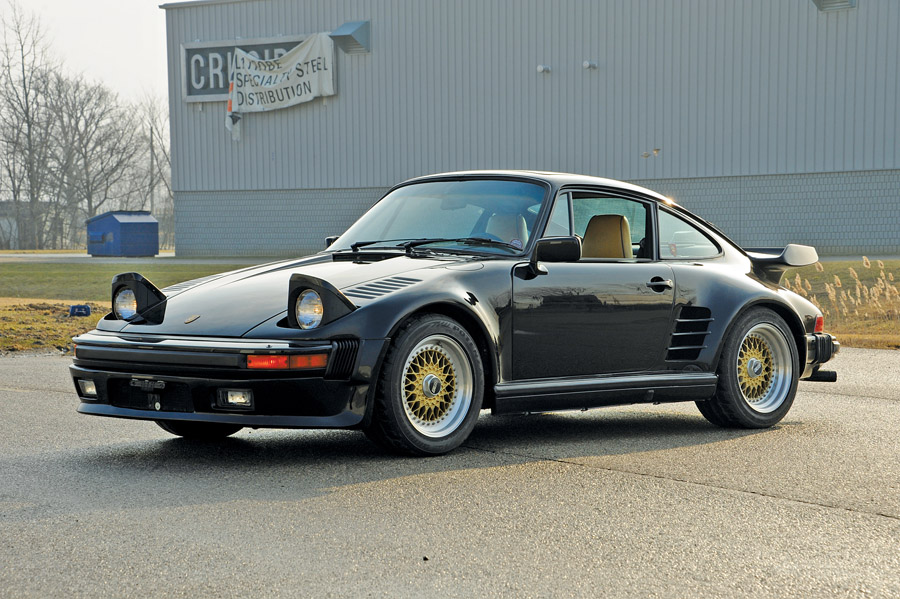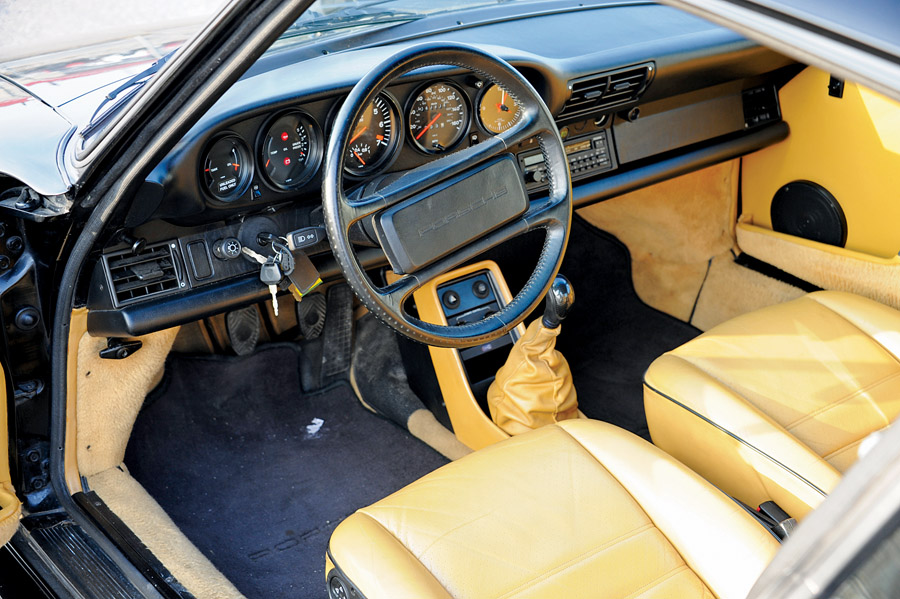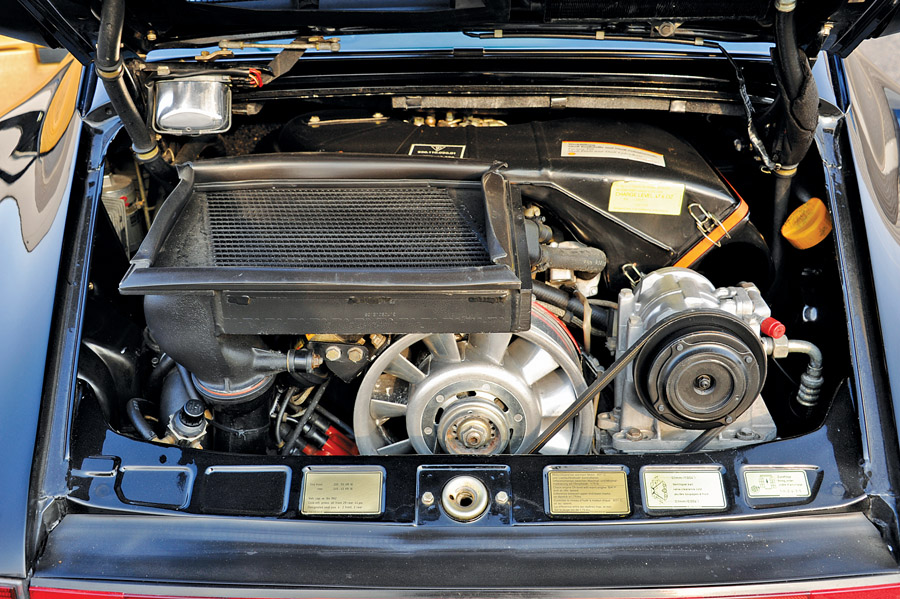- 3.3-liter turbocharged SOHC flat 6-cylinder engine
- 4-speed manual transmission
- Reported to be number 11 of 25 Blackburn-Daly “Slantnose” conversions built in the 1980s
- Believed to be a three-owner car and repainted once
- Porsche CoA, owner’s manuals, service records and maintenance booklet (with service stamps)
- Original tools, air compressor and two replacement belts
- Blaupunkt radio
- Air conditioning
- Two sets of master keys
- Spare tire and jack
- BBS wheels
- Alarm
- Sunroof
SCM Analysis
Detailing
| Vehicle: | 1987 Porsche 911 Turbo Slantnose Coupe |
| Years Produced: | 1975–89 (all 930 generations) |
| Number Produced: | 2,481 in 1987, 20,685 930s in total |
| Original List Price: | $58,750 in 1987 |
| SCM Valuation: | $109,450 |
| Tune Up Cost: | $2,500, including valve adjustment |
| Chassis Number Location: | Label on driver’s B-pillar; tag inside windshield; center of panel above gas tank has RoW worldwide version of serial number |
| Engine Number Location: | On fan support upright, passenger side |
| Club Info: | Porsche Club of America |
| Website: | http://www.pca.org |
| Alternatives: | Porsche 911 Carrera 3.2, 1986–91 BMW E30 M3, 1988–91 Ferrari F40, 1985–88 Mazda RX-7 Turbo |
| Investment Grade: | B |
This car, Lot 246, sold for $71,500, including buyer’s premium, at Auction America’s Fort Lauderdale, FL, event on March 31, 2017.
Porsche popularized turbocharged production cars when its 930 was launched in 1975 in Europe and in 1976 in North America. This came after Porsche had shown a prototype — in handsome silver with white markings — at the October 1973 Frankfurt Auto Show and the production car at the Paris show in October 1974.
The car world responded with enthusiasm.
Porsche was not the first manufacturer in the modern era to market a turbo, although Engineering Chief Ferdinand Piech had the company playing with street Turbos as early as 1969 — about the same time they began to address turbocharged race cars.
While mechanical supercharging and exhaust-driven turbocharging go back to the turn of the 20th century, General Motors kicked off the modern era of turbos with their Chevrolet Corvairs and Oldsmobile Jetfires in the early 1960s. Michael May’s turbo-modified Capri V6s and then the BMW 2002 turbos raised interest before Porsche got to market.
Nonetheless, after 1976 when one said “Turbo,” it was instantly understood that you were talking about a Porsche.
Performance lightweight or luxury tourer
For a while, Porsche thought about the 930 as a purist automobile like the 1973 Carrera RS. Instead, management decided on a high-speed luxurious touring car with a price to match.
The Turbo was a departure from all existing 911s, first in appearance with muscular fender flares over wider wheels and with a “whale tail” on the rear lid. The 2,993-cc engine started with 50 more horsepower than Porsche 911s ever had, at 260 in Europe but only 234 in North America — thanks to emissions controls and lower-grade gasoline.
Power was delivered through a beefed-up 4-speed gearbox — a source of owners’ complaints for years to come. The 930 Turbo came standard with air conditioning, AM/FM stereo, power windows and full leather (in North America). As introduced, the car weighed 300 pounds more than a 911, 70 of which was the turbo-equipped engine. It was 80% more expensive at $25,880 for the Turbo to $13,845 for the 911.
What are the performance numbers?
|
Model |
1976 Turbo |
1976 911S |
0–60 mph |
|
4.9 seconds |
7.5 seconds |
7.8 seconds |
|
|
Quarter-mile time |
13.5 seconds |
15.8 seconds |
16.3 seconds |
|
Top speed |
156 mph |
138 mph |
142 mph |
|
Lateral Gs |
0.852 |
0.779 |
0.881 |
|
Displacement ccs |
2,993 |
2,687 |
2,341 |
|
Compression ratio |
6.5:1 |
8.5:1 |
8.5:1 |
|
Horsepower |
234 |
165 |
190 |
|
Torque |
246 |
168 |
154 |
|
Weight base/as tested |
2,785/3,155 |
2,475/2,845 |
2,570/2,870 |
|
Base price |
$25,880 |
$13,845 |
$10,160 |
This chart first appeared in an article by this author in Porsche Panorama in October 2014.
The performance spoke for itself. The Turbo was the fastest 911 ever made, and it was instantly desirable despite the substantial price. Porsche redesigned the engine for the 1978 model with a displacement increase to 3,299 cc, a slightly higher compression ratio, and an intercooler to get a more compact air charge for the turbocharger — but no increase in boost at 0.8 bar. Horsepower went up to 265 in North America and 300 everywhere else. Wheels had been increased in size to 16 inches in diameter with seven-inch and eight-inch widths in 1977.
The Turbo exits North America … and then returns
1979 was the last year for North American Turbos because of more-stringent U.S. emissions laws — until 1986, when they returned.
During the absence, enterprising aftermarket dealers imported “gray market” Turbos and modified them to meet U.S. laws. Porsche dealers hated that, and finally, Porsche AG’s American President, Peter Schutz, succeeded in the comeback.
Turbos came back in 1986, complete with catalytic converters and 282 horsepower. The reopened U.S. market doubled sales of the 930. Porsche introduced one last big improvement in 1989, when it moved the G50 5-speed gearbox to the Turbo, finally addressing 14 years of drivers’ complaints. After 1989, the 930 disappeared again but just for a year, to return as a much different car — the 964 Turbo. There has been a Turbo model ever since, for 42 years now. This would be very impressive were it not for its older brother, the 911, at 54 years.
Enter the Slantnose Turbo
Starting in 1981, Porsche’s Service and Repairs Department would “customize” cars for buyers who asked for and could pay for the hand-crafting service.
The program made extra money for Porsche (which was not profitable in 1980), and it slammed the tuners, such as DP, Gemballa, Koenig, Kremer and Ruf. Soon it was an organized activity known as Sonderwunsch (Special Wishes). It quickly became the Exclusive Department, always under the aegis of Rolf Sprenger.
The department specialized in Slantnose, boxed-rocker, rear-fender-scooped 930s. By 1987, Porsche offered this package as the readily available option M505.
Between 1987 and 1989 Porsche made 948 Flachbaus, or “Flatnoses,” which were more commonly known in the U.S. as “Slantnoses” or just “Slants.” Whether you love them or don’t, Turbo Slants became very collectible earlier this decade, with prime-condition 1989 5-speed cabriolets besting $300,000 and coupes $250,000. Those days are past now, but some of the cars still demand premium six-figure prices — and occasionally pop a big sale.
Just a car for just-a-car money
The Porsche factory’s Slantnose modifications added 50% to 100% to the cost of a standard Turbo. That pricing created an umbrella under which the “tuners” and “customizers” continued to work — in Europe and in the U.S. One of the latter was Blackburn-Daly in Indianapolis, an enterprise John Blackburn created with Irishman Derek Daly, a former Formula One and Two driver, who was then racing CART Indycars and living locally.
Their packages imitated the Porsche Factory’s slant package — often with factory parts — at a lower price. Reportedly, they built about 25 such conversions, mostly on Turbos, but we have also seen a 911SC they modified.
Auction America’s Blackburn-Daly 930 offered at Fort Lauderdale was just a car. It was repainted, had an indicated 40,900 miles, and had that non-factory Slant conversion. With over 20,000 Turbos built between 1975 and 1989, to be collectible a 930 needs to be very special. That means very low mileage, a rare attractive color, stripped to the max to be a “lightweight” or very heavily and specially optioned.
Our subject car was none of those.
There is only a middling market for driver-quality 930s with mileage. Similar 911s offer good value and performance without the prospect of expensive maintenance. An all-in $71,500 was all the money for this example, but its new owner does get the look of an M505 for at least a 50% discount. ♦
(Introductory description courtesy of Auctions America.)


